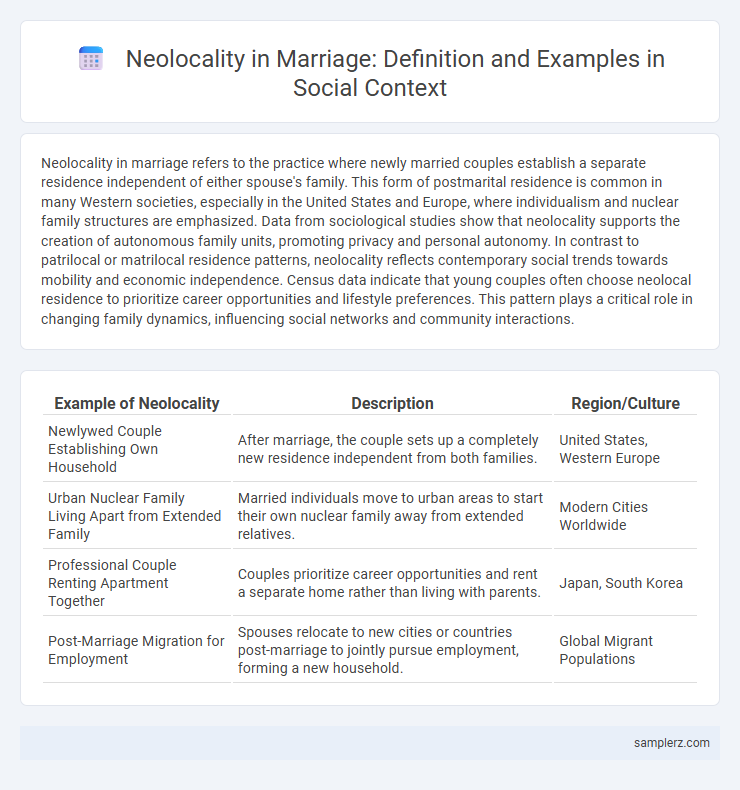Neolocality in marriage refers to the practice where newly married couples establish a separate residence independent of either spouse's family. This form of postmarital residence is common in many Western societies, especially in the United States and Europe, where individualism and nuclear family structures are emphasized. Data from sociological studies show that neolocality supports the creation of autonomous family units, promoting privacy and personal autonomy. In contrast to patrilocal or matrilocal residence patterns, neolocality reflects contemporary social trends towards mobility and economic independence. Census data indicate that young couples often choose neolocal residence to prioritize career opportunities and lifestyle preferences. This pattern plays a critical role in changing family dynamics, influencing social networks and community interactions.
Table of Comparison
| Example of Neolocality | Description | Region/Culture |
|---|---|---|
| Newlywed Couple Establishing Own Household | After marriage, the couple sets up a completely new residence independent from both families. | United States, Western Europe |
| Urban Nuclear Family Living Apart from Extended Family | Married individuals move to urban areas to start their own nuclear family away from extended relatives. | Modern Cities Worldwide |
| Professional Couple Renting Apartment Together | Couples prioritize career opportunities and rent a separate home rather than living with parents. | Japan, South Korea |
| Post-Marriage Migration for Employment | Spouses relocate to new cities or countries post-marriage to jointly pursue employment, forming a new household. | Global Migrant Populations |
Understanding Neolocality in Modern Marriages
Neolocality in modern marriages is characterized by couples establishing an independent household separate from both sets of parents, emphasizing autonomy and privacy. This living arrangement promotes individualism and often aligns with urbanization trends and career mobility, reflecting contemporary social values. Research indicates that neolocal residence supports stronger marital dynamics by enabling couples to negotiate roles and responsibilities without extended family interference.
Key Features of Neolocal Residence Patterns
Neolocal residence patterns in marriage involve newlyweds establishing an independent household separate from both the husband's and wife's families. Key features include autonomy in household decision-making, economic self-sufficiency, and personalized domestic arrangements tailored to the couple's preferences. This pattern reflects modern social values emphasizing individualism and nuclear family independence.
Neolocality vs. Traditional Family Systems
Neolocality in marriage refers to newlyweds establishing an independent household separate from both the husband's and wife's families, contrasting with traditional family systems where married couples typically reside with or near extended family. This practice supports nuclear family autonomy and is common in urban and industrial societies promoting individualism. Studies show neolocal residency fosters economic independence and privacy, differing significantly from patrilocal or matrilocal practices in collectivist cultures.
Global Examples of Neolocality in Marriage
Neolocality in marriage is commonly observed in urban centers such as New York City, London, and Tokyo, where newlyweds establish independent households separate from their parents. In Scandinavian countries like Sweden and Norway, neolocal residence is a prevalent cultural norm supported by strong social welfare systems. Urban migration trends in countries like Brazil and India also reflect neolocal practices as couples seek economic opportunities away from traditional family homes.
Neolocal Living: Couples Setting Up Their Own Homes
Neolocal living is a common practice where newly married couples establish independent households separate from both sets of parents, emphasizing autonomy and self-reliance. This arrangement supports modern values of privacy and equality within marriage, reflecting social shifts toward individualism. Studies show neolocal residence patterns are prevalent in Western societies and increasingly popular worldwide due to economic mobility and changing family dynamics.
Neolocality Among Urban Newlyweds
Neolocality among urban newlyweds is increasingly common as couples establish independent households separate from their families of origin. This residence pattern allows young couples in metropolitan areas to balance career opportunities and personal autonomy while navigating urban housing markets. Studies show that neolocality supports the development of modern family dynamics and promotes economic self-sufficiency in diverse social environments.
Influences of Neolocality on Family Dynamics
Neolocality in marriage leads to couples establishing independent households separate from their families of origin, fostering autonomy and privacy in family dynamics. This living arrangement encourages couples to develop unique roles and decision-making processes, reducing intergenerational influence and potential conflicts. The separation often results in strengthened spousal bonds and facilitates adaptive parenting styles tailored to the nuclear family's needs.
Neolocal Residence and Gender Roles
Neolocal residence, where newlywed couples establish an independent household separate from both families, significantly influences gender roles by promoting more egalitarian domestic responsibilities. This residential pattern encourages shared decision-making and balances work distribution between spouses, contrasting with traditional patrilocal or matrilocal arrangements. Studies show neolocality contributes to greater gender equality by fostering mutual support and flexibility in marital roles.
Sociocultural Shifts Encouraging Neolocality
Neolocality in marriage, where newlyweds establish an independent residence, reflects significant sociocultural shifts such as increased individualism, economic independence, and urbanization. Changing gender roles and higher educational attainment contribute to couples prioritizing personal space and career opportunities over traditional extended family living arrangements. This shift promotes autonomy and reshapes family dynamics in contemporary societies.
Challenges and Benefits of Neolocality in Marriage
Neolocality in marriage, where newlyweds establish an independent residence separate from both families, presents challenges such as financial strain due to setting up a new household and potential emotional distance from extended family support systems. Benefits include fostering autonomy and strengthening the marital bond through shared responsibilities and decision-making in a new environment. This residential pattern encourages the development of a self-reliant family unit, which can promote long-term stability and individual growth within the marriage.

example of neolocality in marriage Infographic
 samplerz.com
samplerz.com